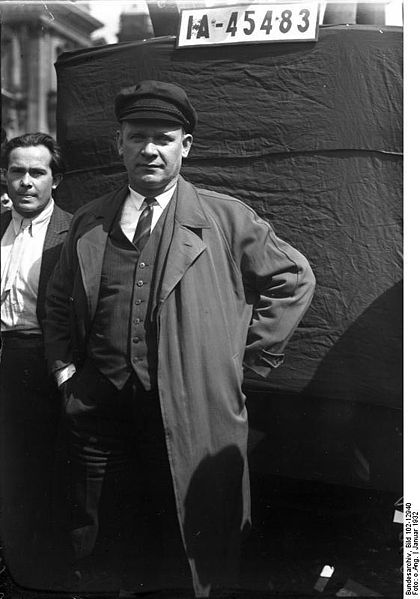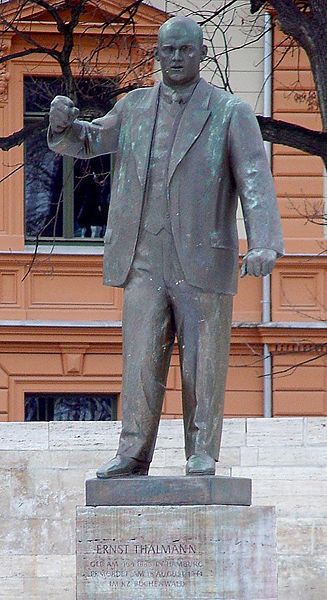<Back to Index>
- Mathematician Ferdinand Gotthold Max Eisenstein, 1823
- Actor and Director Sir Charles Spencer "Charlie" Chaplin, 1889
- German Communist Politician Ernst Thälmann, 1886


Ernst Thälmann (16 April 1886 – 18 August 1944) was the leader of the Communist Party of Germany (KPD) during much of the Weimar Republic. He was arrested by the Gestapo in 1933 and held in solitary confinement for eleven years, before being shot in Buchenwald on Adolf Hitler's orders in 1944. In 1936, the Thälmann Battalion of the International Brigades during the Spanish Civil War was named in his honour.
Born in Hamburg, Thälmann was a Social Democratic Party member from 1903. Between 1904 and 1913 he worked as a stoker on a freighter. He was discharged early from his military service as he was already seen as a political agitator.
One day before his call up for military service in World War I in January 1915, he married Rosa Koch. Towards the end of 1917 he became a member of the USPD (Independent Socialist Party of Germany). On the day of the German Revolution, 9 November 1918, he wrote in his diary on the Western Front, "...did a bunk from the Front with 4 comrades at 2 o'clock." When the USPD split over the question of whether to join the Comintern, Thälmann sided with the pro-Communist group which in November 1920 merged with the KPD.
In December Thälmann was elected to the Central Committee of the
KPD. In March 1921 he was fired from his job at the job centre due to
his political activities. That summer Thälmann went as a
representative of the KPD to the 3rd Congress of the Comintern in Moscow and met Lenin.
In June 1922 Thälmann survived an assassination attempt at his
flat. Members of the right-wing nationalist organisation Consul threw a
hand grenade into his ground floor flat. His wife and daughter were
unhurt; Thälmann himself came home only later. Thälmann participated in and helped organise the Hamburg Uprising of October 1923. The uprising failed, and Thälmann went underground for a time. After the death of Leninin January 1924, Thälmann visited Moscow and for some time maintained a guard of honour at his bier. From February 1924 he was deputy chairman of the KPD and, from May, a Reichstag member.
At the 5th Congress of the Comintern that summer he was elected to the
Comintern Executive Committee and a short time later to its Steering
Committee. In February 1925 he became chairman of the Rote Frontkämpferbund
(RFB), the defence organisation of the KPD. In October 1925
Thälmann became Chairman of the KPD and that year was a candidate
for the German Presidency.
Thälmann's candidacy in the second round of the presidential
election split the centre-left vote and ensured that the conservative Paul von Hindenburg defeated the Centre Party's Wilhelm Marx. In 1933 Hindenburg would appoint Adolf Hitler as German Chancellor. In
October 1926 Thälmann supported in person the dockers' strike in
his home town of Hamburg. He saw this as solidarity with a British miners' strike which
had started on 1 May and had been good for the business of Hamburg
Docks as an alternative supplier of coal. Thälmann's argument was
that this "strike-breaking" in Hamburg had to be stopped. In March he
took part in a demonstration in Berlin, where he was injured by a blow
from a sword. At
the 12th party congress of the KPD in June 1929 in Berlin-Wedding,
Thälmann, in conformity with the position adopted by the Soviet
leadership under Stalin,
adopted a policy of confrontation with the SPD. This followed the
events of "Bloody May", in which 32 people were killed by the police in
an attempt to suppress demonstrations which had been banned by the
Interior Minister, Carl Severing,
a Social Democrat. During that time, Thälmann and the KPD fought
the SPD as their main political enemy, acting according to the Comintern policy which declared Social Democrats and Socialists to be "social fascists". Already in 1927, Karl Kilbom, the Comintern representative to Germany, had started to combat this ultra leftist tendency of Thälmann within the German Communist Party, but found it to be impossible when he found Stalin was
against him. Another aspect of this strategy was to attempt to win over
the leftist elements of the Nazi Party, especially the SA, who largely
came from a working class background and supported socialist economic
policies. These guidelines on Social Democracy as "social fascism"
remained in force until 1935 when the Comintern officially switched to
endorsing a "popular front" of socialists, liberals and even
conservatives against the Nazi threat. By that time, of course, Hitler
had come to power and the KPD had largely been destroyed. In March 1932, Thälmann was once again a candidate for the German Presidency, against the incumbent Paul von Hindenburg and Adolf Hitler.
The KPD's slogan was "A vote for Hindenburg is a vote for Hitler; a
vote for Hitler is a vote for war." Thälmann returned as a
candidate in the second round of the election, as it was permitted by
the German electoral law, but his vote count lessened from 4,983,000
(13.2%), in the first round, to 3,707,000 (10.2%), which seems to
indicate that, despite his fierce opposition, Hindenburg received more
than a million of communist votes. After the Nazis came to power in
January 1933, Thälmann proposed that SPD and KPD should organise a general strike to
topple Hitler, but this was not achieved. In February 1933, a Central
Committee meeting of the already banned KPD took place in Königs Wusterhausen at
the "Sporthaus Ziegenhals", near Berlin, where Thälmann called for
the violent overthrow of Hitler's government. On 3 March he was
arrested in Berlin by the Gestapo. Thälmann's
trial – which he said he looked forward to – never took place.
Thälmann's interpretation was that his two defence lawyers, both
Nazi Party members (whom he nonetheless trusted to a certain extent) at
some point gathered that he planned to use the trial as a platform to
appeal to world public opinion and denounce Hitler, and had told the
court. Furthermore, Thälmann assumed that after the failure of the
trial of Georgi Dimitrov for complicity in the Reichstag fire,
the Nazi regime did not want to allow the possibility of further
embarrassment in the court room. For his 50th birthday in April 1936
Thälmann received greetings from around the world, including from Maxim Gorky and Heinrich Mann. That same year the Spanish Civil War broke out, and two units of the International Brigades named
themselves after him. Thälmann spent over eleven years in solitary
confinement. In August 1944 he was transferred from Bautzen prison to Buchenwald concentration camp,
where on 18 August, on Hitler's orders, he was shot and his body
immediately burned. Shortly after, the Nazis announced that together
with Rudolf Breitscheid, Thälmann had died in an Allied bombing attack on 23 August. While heading the KPD, Thälmann closely aligned the German Communists with the hegemony of the Soviet Communist Party. Supporters of a more autonomous course were expelled. A leading German communist, Clara Zetkin,
described Thälmann as "uninformed and not educated in theory", and
as caught in "uncritical self-deception and self-infatuation [which]
borders on megalomania." During World War I and the Weimar Republic, the KPD competed for leadership of the working class with the more moderate SPD,
particularly after the latter supported German involvement in the War.
Thälmann and the KPD focused their attacks primarily on the SPD to
prevent it from retaining power. Unfortunately, Thälmann did this
at the expense of ignoring the then-young Nazi Party, which likely allowed them to gain power several years later. After 1945, Ernst Thälmann, and other leading communists who had died violently, such as Rosa Luxemburg and Karl Liebknecht, were widely honoured in East Germany, with many schools, streets, factories, etc., named after them. Most of these names were abolished after German reunification though it is still possible to find places named after Thälmann in cities like Berlin, Hamburg, and Frankfurt an der Oder. In the 1950s, an East German film in two parts, Ernst Thälmann (film), was made. In 1972, Cuba named a small island, Cayo Ernesto Thaelmann, after him.